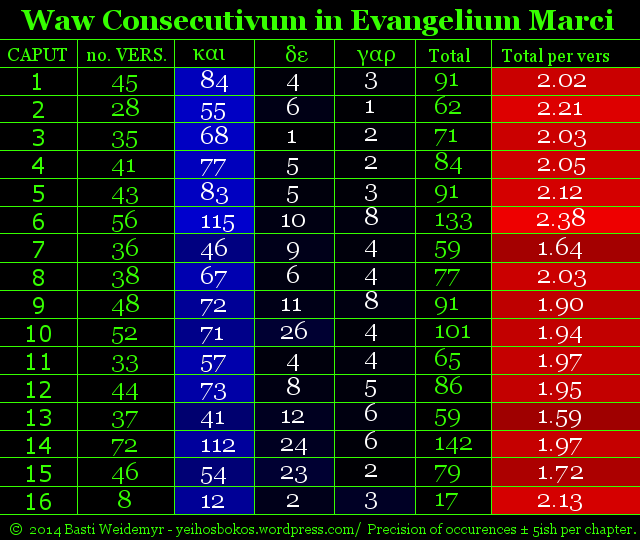Just a little introduction. We have testimony from early Christians, Papias as cited by Eusebios and Hieronymus/Jerome saying Matthew wrote in his own language in Hebrew characters. The remaining books of the New Testament have been assumed by many to have been written in Greek, but some suggest Aramaic, and in the case of the Gospel according to Mark, Latin has been mentioned.
The arguments for Latin are pretty good but not waterproof. This site is a good summary:
http://www.mycrandall.ca/courses/ntintro/mark.htm
Against the idea that it was written in Latin, stands the fact that the Gospel according to Mark is shock full of sentences on the form: conjunction – verb – the rest. This word order is typical of semitic texts. If, in addition, the conjunction seems out of place and is part of a narrative, it is almost certainly a case of waw-consecutive, a semitic phenomenon.
Out of curiosity, I made a little graphic to find out if:
1. this happened where Yesus was speaking, for Yesus probably spoke the mostly semitic language of Syriac/Aramaic.
2. it happened only in sections of the gospel while other parts looked rather Indo-European. For some of the material in Mark may have come from notes made by a disciple and which was common to the authors of Matthew, Mark and Luke. And some of the material probably came from Simon Petros, who worked closely with a certain Mark.
No 1 is not answered by the graphic but it seems that Yesus used waw-consecutive-style constructions a little less than the narrative surrounding the quotes from his teaching. In any case, the waw-consecutives in Mark cannot be explained away as being caused by the Aramaic of Yesus Christ.
No 2 is indicated by the graphic. If there is a breaking point, such that Peter wrote most of some chapters and Mark wrote most of some others, it should be late in chapter 6. However, there are alternative explanations, mainly that from chapter 7 onwards, the focus shifts from the lords miracles and parables to describing events among the disciples and clashes with the pharisees, so the word “but” became more useful in the narrative in place of “and”. Later translators may have begun to feel, around chapter 7, that there were so many “and” that they could not endure it any more and had to omit some or replace them with similar narrative words.
The most obvious conclusion is that waw-consecutive is ubiquitous therein.
In the graphic, occurrences of και, δε and γαρ were counted even when they occurred in constructions that could not be waw-consecutive. The colour indicates number of occurrences per verse and errors may come from the fact that verses have different lengths. A digital copy of Wescot & Hort’s critical Alexandrian Greek text was used.

Finally a word of caution. Discussions about “primacy”, that is which language a scripture was first written in, can seem incredibly convincing to a beginner. Do not be too fast to draw conclusions. Just because some expert has proven you wrong about book X being written in language Y, it does not mean you have to believe that expert when he says all of the books were written in language Z, or you would have to change your stance several times per year. For there is really convincing evidence in all directions and there is no reason to think all of the books were written in the same language. Or to think they were written in just one language.
So the waw-consecutives of Mark suggest a Semitic language because in ancient times translations were usually very literal and mechanical. Not like today when we like to translate thoughts rather than words. So, the word-order betrays a Semitic original, but it may have been released in Latin … or Greek … or both.
